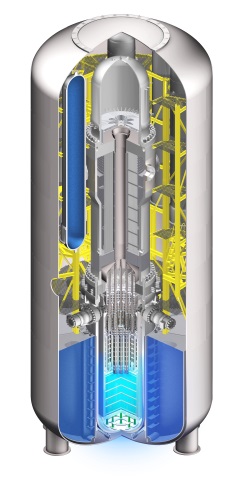Westinghouse looks to UK for vessel manufacture
03 March 2016
Westinghouse Electric Company has announced a manufacturing study to investigate the production of reactor pressure vessels for its small modular reactor in the UK through a collaboration with the Nuclear Advanced Manufacturing Research Centre.
The NAMRC will provide an independent assessment of the current Westinghouse SMR RPV design, and determine an optimal manufacturing solution. A key component of the study will be the identification of efficiencies within the advanced manufacturing process to significantly reduce capital costs and drive project savings. Westinghouse said that the study will "utilise expert knowledge of local manufacturing capabilities to identify potential suppliers for when the Westinghouse SMR enters production."
 |
A cutaway of the SMR vessel
(Image: Westinghouse) |
The NAMRC is a collaboration of academic and industrial partners from across the civil nuclear manufacturing supply chain, and was established in 2012 with the mission of helping UK manufacturers win work at home and worldwide. With extensive experience in design for the manufacture of large complex parts for safety-critical applications, the centre can draw on broad academic and industry knowledge, Westinghouse said.
Westinghouse senior vice president for new plants and major projects, Jeff Benjamin, said the Westinghouse SMR built upon the company's extensive reactor and fuel technology expertise. "The efficient construction of Westinghouse Small Modular Reactors can plan an important part of the UK's future by creating local manufacturing jobs to develop safe, clean and economical energy," he said. The company recently declared its fuel manufacturing facility at Springfields in north-western England had reached the requirements necessary to fabricate SMR fuel.
The Westinghouse SMR is a 225 MWe integral pressurized water reactor design with all primary components located inside the reactor vessel and utilizes the passive safety functionality developed for the company's AP1000 reactor, currently being built at sites in China and the USA. The SMR design's reliance on existing technology and the proven licensing basis should likely reduce development time and licensing risk for the reactor.
In October 2015 Westinghouse - part of the Toshiba group - put forward a proposal to the UK government to partner in the deployment of the company's SMR technology, a move that the company said would advance the UK from a buyer to a provider of the technology. That proposal envisaged a shared design and development model in a UK-based enterprise, jointly owned by Westinghouse, the UK government and UK industry.
Also in October 2015, US-based NuScale announced that it was looking for partners to deploy its own small modular reactor technology in the UK. The following month, the UK government announced plans to invest at least £250 million ($377 million) over the next five years in an "ambitious" nuclear research and development program to include a competition to identify the best value SMR design for the UK. Detailed plans for the competition have not yet been announced.
Any small modular reactor design to be built in the UK will first need to complete the Generic Design Assessment (GDA) process of the country's regulators, the Office for Nuclear Regulation and the Environment Agency. GDAs are currently under way for Hitachi-GE's UK Advanced Boiling Water Reactor (UK ABWR) and Westinghouse’s AP1000 reactor designs.
Researched and written
by World Nuclear News